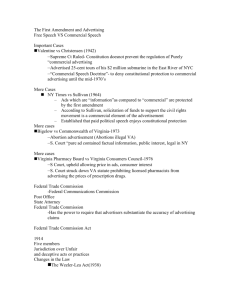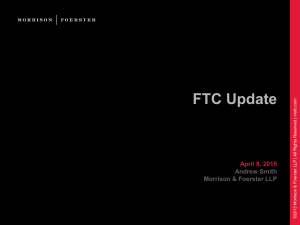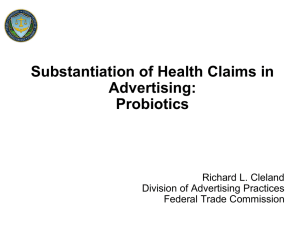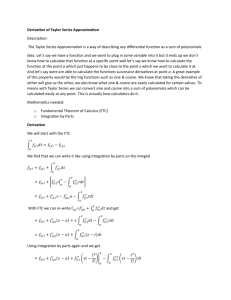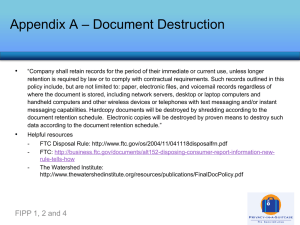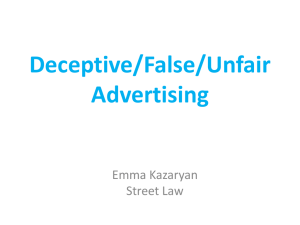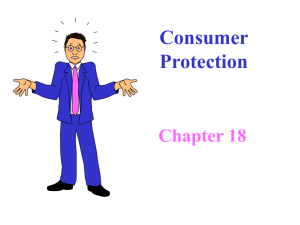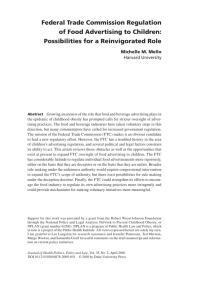Insurance - Federal Trade Commission on Advertising
advertisement
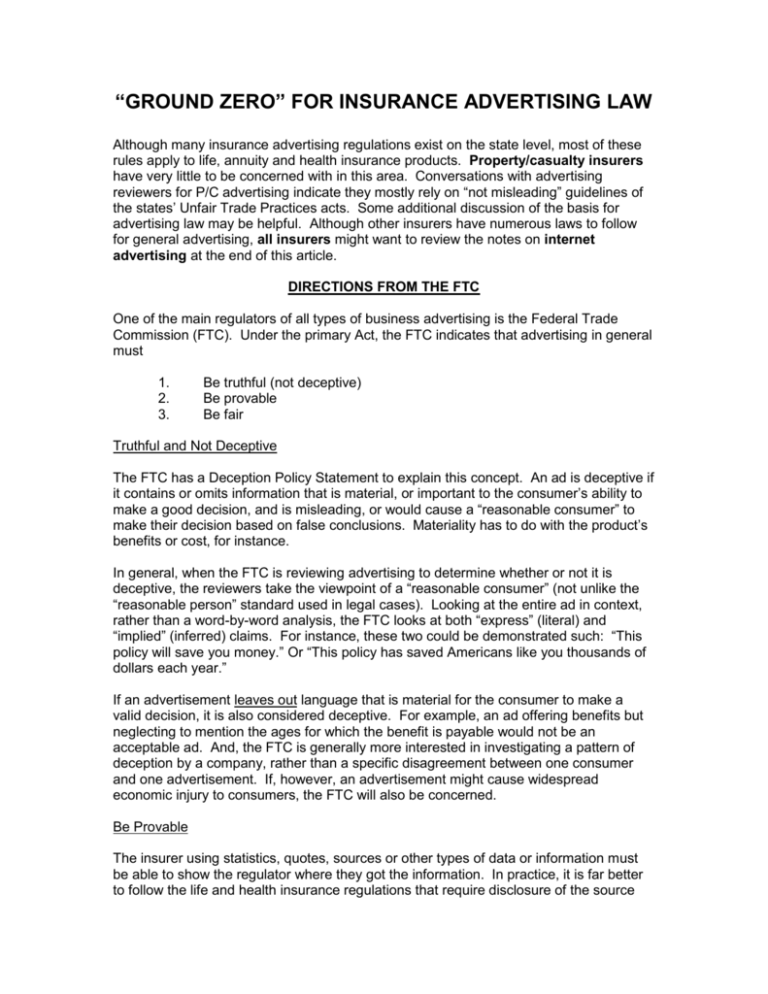
“GROUND ZERO” FOR INSURANCE ADVERTISING LAW Although many insurance advertising regulations exist on the state level, most of these rules apply to life, annuity and health insurance products. Property/casualty insurers have very little to be concerned with in this area. Conversations with advertising reviewers for P/C advertising indicate they mostly rely on “not misleading” guidelines of the states’ Unfair Trade Practices acts. Some additional discussion of the basis for advertising law may be helpful. Although other insurers have numerous laws to follow for general advertising, all insurers might want to review the notes on internet advertising at the end of this article. DIRECTIONS FROM THE FTC One of the main regulators of all types of business advertising is the Federal Trade Commission (FTC). Under the primary Act, the FTC indicates that advertising in general must 1. 2. 3. Be truthful (not deceptive) Be provable Be fair Truthful and Not Deceptive The FTC has a Deception Policy Statement to explain this concept. An ad is deceptive if it contains or omits information that is material, or important to the consumer’s ability to make a good decision, and is misleading, or would cause a “reasonable consumer” to make their decision based on false conclusions. Materiality has to do with the product’s benefits or cost, for instance. In general, when the FTC is reviewing advertising to determine whether or not it is deceptive, the reviewers take the viewpoint of a “reasonable consumer” (not unlike the “reasonable person” standard used in legal cases). Looking at the entire ad in context, rather than a word-by-word analysis, the FTC looks at both “express” (literal) and “implied” (inferred) claims. For instance, these two could be demonstrated such: “This policy will save you money.” Or “This policy has saved Americans like you thousands of dollars each year.” If an advertisement leaves out language that is material for the consumer to make a valid decision, it is also considered deceptive. For example, an ad offering benefits but neglecting to mention the ages for which the benefit is payable would not be an acceptable ad. And, the FTC is generally more interested in investigating a pattern of deception by a company, rather than a specific disagreement between one consumer and one advertisement. If, however, an advertisement might cause widespread economic injury to consumers, the FTC will also be concerned. Be Provable The insurer using statistics, quotes, sources or other types of data or information must be able to show the regulator where they got the information. In practice, it is far better to follow the life and health insurance regulations that require disclosure of the source and date of any statistics. The law requires the information be provable before an ad is published by an insurer. The insurer must be able to verify the information if challenged – which means at least maintaining the source and date in the historical ad file. One way to put this concept is, “If you can’t prove it, you can’t print it!” In looking at “express” and “implied” claims, regulators expect insurers to be able to prove either. Evidence must provide a “reasonable basis”, meaning objective evidence that supports the claim. The FTC may review what experts in the field think will support such a claim. Any substantiating surveys or comparisons must have been conducted by accepted industry standards. The FTC focuses on national advertising that claims safety or health benefits, and claims that consumers probably could not evaluate themselves, such as “lowest cost in the industry”. An ad that states, however, “we may lower your cost”, receives less attention. Be Fair According to the FTC’s Unfairness Policy Statement, there are two measures of fairness. One is a question of balance – if the benefit to the consumer is outweighed by the misstatements in an ad, then it is deemed to be unfair. Also, if the statements cause or are likely to cause the consumer substantial injury, it is unfair. In insurance terms, this might be causing financial injury to the consumer through penalties or additional charges because of misstatements. DISCIPLINARY TOOLS FOR THE FTC If a company is found to be in violation of these tenets of the FTC’s guidelines, there are several penalties that can be imposed. Cease and Desist Legally binding, this penalty requires companies to stop running that particular ad or stop engaging in deceptive practices. The companies under this order may also be required to have substantiation for claims in future ads and report that documentation periodically. The FTC has the authority to impose a fine of $11,000 per day if the company engages in the same practices in the future. Monetary Remedies Civil penalties can range from thousands to millions of dollars, depending on the severity of the company’s violation. Companies have also been ordered to give full or partial refunds to consumers who purchased the advertised product. Informational Remedies Advertisers have been required to provide additional information to the public or to consumers who purchased the product advertised. Sometimes additional ads must be run to correct the original unfair information; sometimes information must be sent out to customers about those deceptive claims. Companies may simply be required to include specific disclosures in future ads. INTERNET ADVERTISING FROM THE FTC PERSPECTIVE In May of 2000, an FTC staff working paper was published to provide guidance on how the current law applies to the internet. The main focus of this working paper is to emphasize that disclosures required in an ad so that the FTC would not consider it misleading, must be presented clearly and conspicuously. The paper provides key considerations to evaluate whether this requirement is being met online, while noting that the actual disclosures will be evaluated in the overall context of the advertisement. The key factors: Placement and proximity - the disclosure is close to the claim made Distraction factors – whether other parts of the ad diminish the attention paid to the disclosure Repetition – whether the ad is long enough that a disclosure should be repeated Duration – whether visual disclosures appear long enough to actually be read Volume and cadence – whether disclosures in audio messages are sufficient in these considerations Clarity – whether the language used is understandable by the target audience BEST PRACTICE RECOMMENDED As mentioned previously, the P/C trade is not regulated by additional state or federal law as the life and health insurance insurers are. However, the Best Practices adopted by some multi-line companies do apply some of those life and health regulations to their P/C business. Some examples are: including source and date when using statistics in an ad, applying stricter standards to local yellow page and other advertising (for instance, with producer designations), and combining P/C complaints with life and/or health complaints about the same producers.

